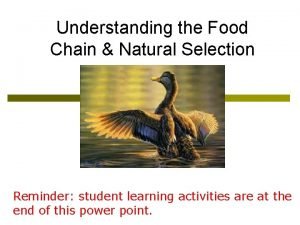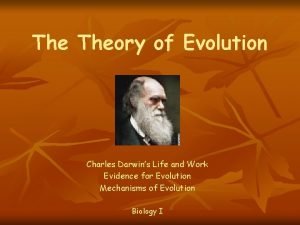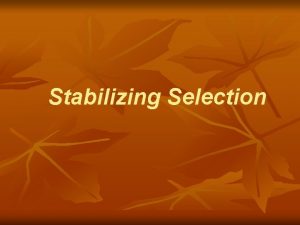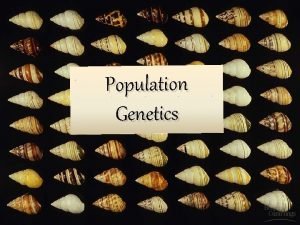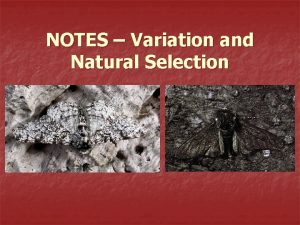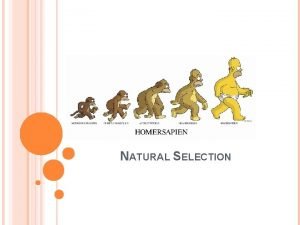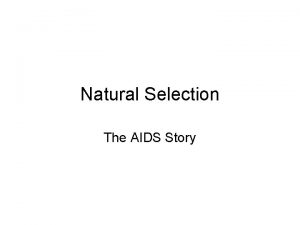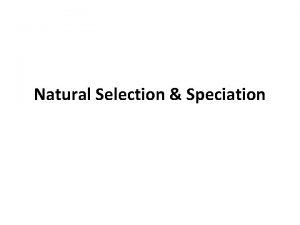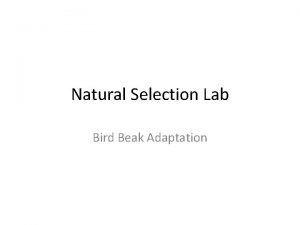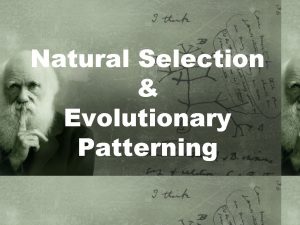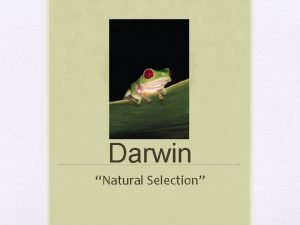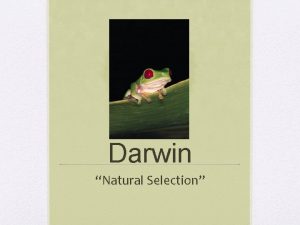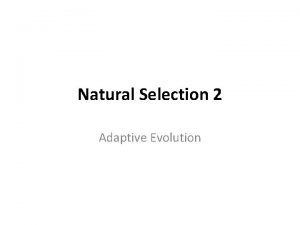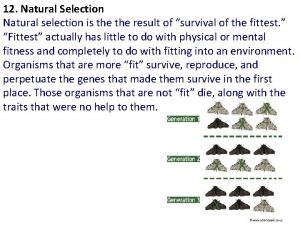Selection 8 6 Starter Define natural selection Individuals

















- Slides: 17

Selection 8. 6

Starter �Define natural selection � Individuals with particular characteristics have a greater chance of survival than individuals without those characteristics, which are therefore more likely to breed and pass on the genes for these characteristics to their offspring. Over many generations these characteristics increase in frequency.

Learning Objectives �Describe how reproductive success affects allele frequency �Define selection �Explain stabilising and directional selection Success Criteria �You can define natural selection �You can order the stages of selection �You can complete an exam question

Allele Frequency and Reproductive Success �Cut out the statements and arrange them into a flow chart to show the stages of how reproductive success will affect allele frequency

Answers �Organisms in a population produce offspring �There is competition between offspring to survive �These members of the population will have a variety of alleles �Those members with certain alleles will be better able to survive the competition �These members survive better, live longer and produce more offspring �Successful individuals pass on their alleles, likely passing on the advantageous ones �Over many generations there will be more individuals with advantageous alleles �So, the frequency of the advantageous alleles will increase

Different types of Selection Different types of selection lead to different frequency patterns: Stabilising Selection and Directional Selection are types of natural selection that affect allele frequency in different ways.

Stabilising Selection �Favours average individuals �Individuals with alleles for characteristics towards the middle of the range are more likely to survive and reproduce �Occurs when the environment is stable �E. g. Mammalian fur length

Example (1) of Stabilising Selection � In any mammal population there is a range of fur length � In a stable climate, having the fur at the extremes of this range reduces the chances of surviving as it is harder to maintain the correct body temperature � Animals with alleles for average fur length are the most likely to survive, reproduce and pass on their alleles. � These alleles increase in frequency. The proportion of the population with average fur length increases and the range of fur length decreases.

A Graph To Show Stabilising Selection Breeding population No. of individuals Total population OFFSPRING Short Fur length Long No. of individuals PARENTS Short Fur length Long

Directional Selection �Favours individuals at one side of the mean �Individuals with alleles for characteristics of an extreme type are more likely to survive and reproduce �This could be a response to environmental change. It causes genetic change in the population.

Example (1) of Directional Selection �Cheetahs are the fastest animals on land. �It is likely that this characteristic developed through directional selection, as individuals that have alleles for speed are more likely to catch prey then slower individuals. �So they are more likely to survive, reproduce and pass on their alleles. �Over time the frequency of alleles for high speed increases and the population becomes faster. FAT FIT

A Graph To Show Directional Selection Breeding population No. of individuals Total population OFFSPRING Slow Speed Fast No. of individuals PARENTS Slow Speed Fast

You will need to be able to interpret data relating to the effect of selection – Describe and explain how and why the frequency has changed. �For example, there are two common forms of the peppered moth in the UK – one dark coloured and one pale coloured (industrial melanism). �The allele for dark colouring is dominant (M) over the allele for pale colouring (m). �The following table shows how allele frequency in a population of peppered moths changed between 1852 and 1860 as the number of coal powered factories in the area increased. Year No. of coal powered factories Frequency of m allele (pale) 1852 1 0. 75 1854 3 0. 70 1856 5 0. 63 1858 7 0. 47 1860 10 0. 39

�The frequency of the m allele (pale) decreases from 0. 75 to 0. 39 as the number of factories increases from 1852 to 1860. So the frequency of the M allele (dark) must increase from 0. 25 to 0. 61 (remember from the Hardy Weinberg equilibrium p + q = 1). �As the allele frequencies are changing, it is likely that there is selective pressure for dark colouring. This could be because of pollution; more factories means more pollution, which darkens buildings etc. The dark coloured moth would be better camouflaged making them more likely to survive, reproduce and pass on the M allele (dark).

Task – Exam Q 1. (a) (i) Time interval of 1 month / too long; Large number of mice born / added to the population in this time /die / lost from population; OR 12 hours is too short a time; For mice to mix in population / be recaptured; OR In non-seed years number of mice is small; So may not catch any / any marked mice; 2 Reject answers about points not covered in the question. (ii) Number of captures will vary with number of traps set / number of traps varies; Standardises results; Allows results to be compared; 2 max

(b) (i) Less than 5% / 1 in 20 probability; Of results being due to chance / luck; Accept converse argument relating to biological significance. 2 (ii) More food; Therefore mice able to produce more young / more mice survive; 2 (c) (i) Mass will vary with sex / one sex is lighter / heavier / females may be pregnant; 1 (ii) Tooth wear linked to age / diet; Confines sample to adult mice / mice eating same food; Otherwise age / food contributes to variation / mass; 2 max

(d) (i) Smaller surface area to volume ratio; So lose less heat; OR More (subcutaneous) fat; Insulation; OR More respiration; More heat produced; 2 (ii) Variation in size is genetic; Selection for / against one extreme (general point not related to data) / for large mice / against small mice; Only larger mice will (survive and) breed / pass on genes; Leads to increase in mean mass; In cold conditions (related to figure); 3 max (e) (i) Grey by grey; Produces some black; 2 (ii) Find frequency / percentage / proportion of black mice; Square root; Use Hardy-Weinberg equation; 2 max [20]
 Similarities
Similarities Natural selection vs artificial selection
Natural selection vs artificial selection Artificial selection vs natural selection
Artificial selection vs natural selection Natural selection vs artificial selection
Natural selection vs artificial selection Natural selection vs artificial selection
Natural selection vs artificial selection Natural hazards vs natural disasters
Natural hazards vs natural disasters Natural capital
Natural capital P**n
P**n 4 principles of natural selection
4 principles of natural selection Stabilizing selection definition
Stabilizing selection definition Genetic drift
Genetic drift Natural selection 3
Natural selection 3 Natural selection
Natural selection Aids basketball player
Aids basketball player 3 types of natural selection
3 types of natural selection Bird beak adaptation lab
Bird beak adaptation lab Types of natural selection in evolution
Types of natural selection in evolution What is evolution and natural selection
What is evolution and natural selection







